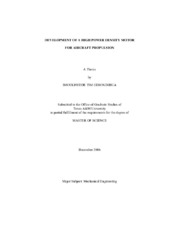| dc.description.abstract | Electric propulsion has been studied for a long time. Most of the electrically
propelled vehicles that have been developed however have been ground vehicles.
Recent research by NASA has promoted the development of electric aircraft. Most
aircraft are currently powered by heavy gas turbine engines that require fueling. The
development of electric motors to replace gas turbines would be a big step towards
accomplishing more efficient aircraft propulsion.
The primary objective of this research extends previous work by developing a
high power density motor for aircraft propulsion. This design is novel because it does
not require a dynamometer to provide the torque to drive the vehicle. Equally important
for successful testing of the motor was the design and development of a spin pit interface
that was used as a containment vessel during testing.
The research led to a designed, fabricated, assembled, modeled, and tested motor.
Voltages, currents and power outputs of the motor were measured and used to determine
the motor’s efficiency. The gaps between the motor’s magnets were related to the
current and power it produced, and modifications were made based on this relation. The vibrations of the motor were also studied and MATLAB codes were written and used to
reduce these vibrations.
Significant among the objectives was monitoring the temperatures of the motor’s
stators due to their close association with the rotating parts. The windage and friction
losses between the stators and the magnets provided a challenging hurdle in the research.
These windage and friction losses were predicted, analyzed and measured, and
modifications were made to reduce them.
Finally, results were compiled, tabulated, and analyzed. Results obtained before
and after the modifications were compared, and these comparisons were used to assess
the necessity and effectiveness of the modifications. The efficiency of the motor was
found to be 82.9% and the power density was evaluated as 33.1 W/lb based on a rotor
weight of 497 lb. It was concluded that the litz wire used in the motor has high,
frequency related impedances that could be reduced but not eliminated. | en |


